 If you thought the switchover to digital television was going to be a challenge, spare a thought for the regulators, policy makers and engineers who are already tasked with trying to figure out the best way of re-allocating the spectrum freed up by switching off the analogue broadcasting signal.
If you thought the switchover to digital television was going to be a challenge, spare a thought for the regulators, policy makers and engineers who are already tasked with trying to figure out the best way of re-allocating the spectrum freed up by switching off the analogue broadcasting signal.
There are a multitude of possible new uses for the spectrum released by switchover, including re-allocating (or re-gifting) it back to the very broadcasters who previously used it in order for them to deliver HD and other services.
Mobile providers are also launching a campaign to ensure an allocation for mobile TV over DVB-H, or extending 3G and rolling out mobile broadband services. Some countries may even look to allocate the spectrum to defence and/or emergency service uses. Or it could well be a mix of all of the above – although the resource is finite – hence the issue.
It was this re-allocation process that provided the focus for an event run today by Policy Tracker. Unfortunately, I was only able to attend the first couple of sessions – but the roster of speakers for the day looked very strong indeed. I hope that Policy Tracker will look to do more events, if they are of this calibre.
 The first two sessions focused mainly on the problems associated with harmonisation. It is essential that adjoining states will have to work together to allocate spectrum, if there are not to be interference issues. The ITU’s Regional Radiocommunication Conference (RRC-06) which will be held in Geneva between May 15 and June 16, aims to provide the necessary regulatory framework for national regulators such as Ofcom as they look to re-allocate. This framework will not limit or determine the re-allocation but ensure licence holders meet certain requirements to ensure harmonious use – enforced by national regulators.
The first two sessions focused mainly on the problems associated with harmonisation. It is essential that adjoining states will have to work together to allocate spectrum, if there are not to be interference issues. The ITU’s Regional Radiocommunication Conference (RRC-06) which will be held in Geneva between May 15 and June 16, aims to provide the necessary regulatory framework for national regulators such as Ofcom as they look to re-allocate. This framework will not limit or determine the re-allocation but ensure licence holders meet certain requirements to ensure harmonious use – enforced by national regulators.
It was interesting to note that London’s geographical location – and possible interference in parts of France and Holland – will mean that any allocation for DVB-H services will effectively have to wait until 2012. Ofcom have already stated this – but pressure will surely start to mount when other European cities (where there are no associated interference issues) will start rolling out DVB-H mobile TV starting in 2007.
Interesting comments from Roberto Ercole of the GSM Association, who said that mobile providers were currently unsure about how the reallocation process would work. He said that the industry faced three key issues – regulatory uncertainty, not knowing whether mobile TV would come under the same regulations as broadcasting, and the possible fragmentation of markets due to allocations differing across regions.
 Of course regulatory uncertainty is same for all those looking to unlock the digital dividend (although some argue that the broadcasters are well positioned because they already sit on the spectrum). Whatever happens its going to be a complex and highly political interplay between policy makers, regulators and transnational organisations such as the ITU.
Of course regulatory uncertainty is same for all those looking to unlock the digital dividend (although some argue that the broadcasters are well positioned because they already sit on the spectrum). Whatever happens its going to be a complex and highly political interplay between policy makers, regulators and transnational organisations such as the ITU.
There is a very difficult balance to strike, ensuring that there is enough incentive for potential users to keep investing and developing technologies whilst also ensuring that the released spectrum will be used in the most productive and efficient manner.
A particularly pertinent question from one delegate – that didn’t get an answer – what is that citizen/consumers will get from the re-allocation? Afterall it is citizen/consumers who are effectively having to pay to release the spectrum. Ofcom’s initial proposals on the issue suggest that this is a question that they will look to answer – so we’ll wait and see.
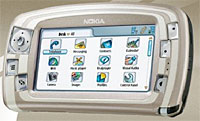 Two recent studies into mobile TV on 3G mobile phones have managed to produce rather inconclusive results concerning the willingness of the great British public to use the service and how much they’d be prepared to pay for it.
Two recent studies into mobile TV on 3G mobile phones have managed to produce rather inconclusive results concerning the willingness of the great British public to use the service and how much they’d be prepared to pay for it.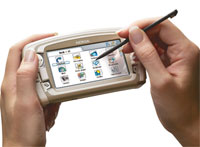 The feedback seemed back-slappingly reassuring, with 83 per cent of the triallists “satisfied” with the service, and 76 per cent indicating they’d be keen to take up the service within 12 months.
The feedback seemed back-slappingly reassuring, with 83 per cent of the triallists “satisfied” with the service, and 76 per cent indicating they’d be keen to take up the service within 12 months.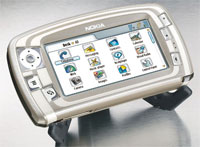 “This trial is further illustration that we are moving from a verbal only to a verbal and visual world in mobile communications,” said David Williams, O2’s technology chief.
“This trial is further illustration that we are moving from a verbal only to a verbal and visual world in mobile communications,” said David Williams, O2’s technology chief.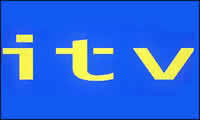 Speculators with a wad of cash might like to consider convert said cash into an ITV plc share holding in the next few days some feel.
Speculators with a wad of cash might like to consider convert said cash into an ITV plc share holding in the next few days some feel.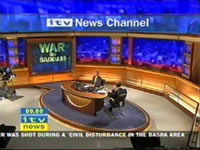 Unlike Sky, which is principally a broadcast platform owner and call centre operator, ITV actually has what companies with desires to be fully-grown media giants badly need; content and a fifty year plus heritage of making TV programmes.
Unlike Sky, which is principally a broadcast platform owner and call centre operator, ITV actually has what companies with desires to be fully-grown media giants badly need; content and a fifty year plus heritage of making TV programmes.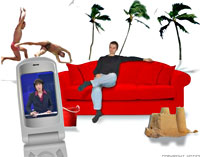 Vodafone has started to roll out its global Mobile TV channels, serving up a feast of “world-class TV brands, pan-European sports coverage and leading entertainment and documentary programmes”.
Vodafone has started to roll out its global Mobile TV channels, serving up a feast of “world-class TV brands, pan-European sports coverage and leading entertainment and documentary programmes”.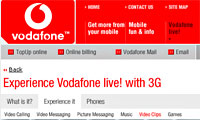 Sports fans will be kept amused on the move with Eurosport, UEFA Champions League and, err, Chilli TV (who?) channels, with the Vodafone service also carrying popular channels like MTV and Discovery.
Sports fans will be kept amused on the move with Eurosport, UEFA Champions League and, err, Chilli TV (who?) channels, with the Vodafone service also carrying popular channels like MTV and Discovery.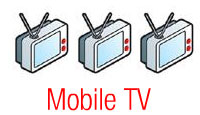 Vodafone say that their research into the market revealed that Mobile TV complemented television viewing habits at home and thus demonstrated a hearty appetite for the product amongst consumers.
Vodafone say that their research into the market revealed that Mobile TV complemented television viewing habits at home and thus demonstrated a hearty appetite for the product amongst consumers. In a sure sign that TV to the mobile is the new European media battleground, 3G mobile operator 3 Italia have announced its plans to purchase the Italian national broadcaster, Canale 7. Reports have put the price of the acquisition at between €30-35m.
In a sure sign that TV to the mobile is the new European media battleground, 3G mobile operator 3 Italia have announced its plans to purchase the Italian national broadcaster, Canale 7. Reports have put the price of the acquisition at between €30-35m.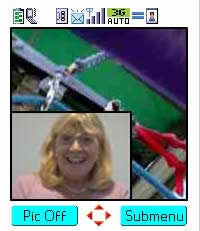 The company intends to offer a DVB-H mobile TV service from the second half of 2006. Indications are that there will be a minimum of 20 channels, although no line up has yet been decided. 3 Italia already carries Playboy adult entertainment and football via existing technology, and has worked with Mediaset and News Corp’s Sky Italia pay-TV operator.
The company intends to offer a DVB-H mobile TV service from the second half of 2006. Indications are that there will be a minimum of 20 channels, although no line up has yet been decided. 3 Italia already carries Playboy adult entertainment and football via existing technology, and has worked with Mediaset and News Corp’s Sky Italia pay-TV operator.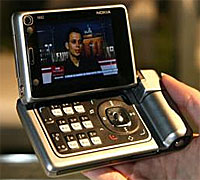 Nokia has announced three more Nokia N series multimedia devices, the Nokia N92 (the world’s first mobile device with a built-in DVB-H receiver), the Nokia N71 and the Nokia N80.
Nokia has announced three more Nokia N series multimedia devices, the Nokia N92 (the world’s first mobile device with a built-in DVB-H receiver), the Nokia N71 and the Nokia N80.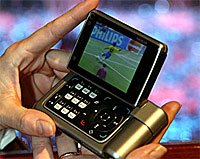 Using the built in software, users can also create personal channel lists, subscribe to TV-channel packages, set program reminders and interact through services such as voting, program feedback and additional web discovery.
Using the built in software, users can also create personal channel lists, subscribe to TV-channel packages, set program reminders and interact through services such as voting, program feedback and additional web discovery.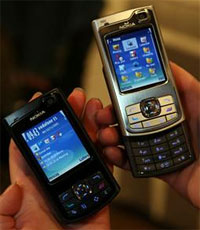 Sporting WLAN and 3G, the Nokia N80 is being touted as the world’s first handset to feature UPnP technology, and has the ability to be used as a remote control for wirelessly swapping content between PCs, audio equipment and TVs.
Sporting WLAN and 3G, the Nokia N80 is being touted as the world’s first handset to feature UPnP technology, and has the ability to be used as a remote control for wirelessly swapping content between PCs, audio equipment and TVs.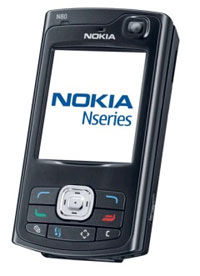 Photos snapped on the Nokia N80 can also be printed wirelessly to any UPnP-enabled printer or photo kiosk.
Photos snapped on the Nokia N80 can also be printed wirelessly to any UPnP-enabled printer or photo kiosk.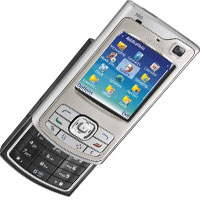 Storage comes in the form of 40 MB of internal memory, with support for miniSD cards of up to 2 GB.
Storage comes in the form of 40 MB of internal memory, with support for miniSD cards of up to 2 GB.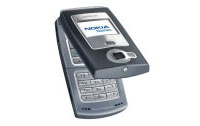 We could only find a teensy-weensy picture of the 3G clam phone as we went to print, but we can tell you that is has two displays and two cameras, one of which is a 2-megapixel camera.
We could only find a teensy-weensy picture of the 3G clam phone as we went to print, but we can tell you that is has two displays and two cameras, one of which is a 2-megapixel camera. After several years of battling with the clunky interface and weird quirks of our museum-ready OnDigital digital terrestrial television box, we decided it was time to replace it with something a little more contemporary.
After several years of battling with the clunky interface and weird quirks of our museum-ready OnDigital digital terrestrial television box, we decided it was time to replace it with something a little more contemporary.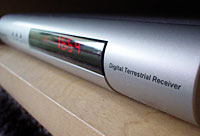 For the princely sum of just £35 (~$62, €52), the Wharfedale offers a digi box with a 7 day electronic programme guide (EPG), digital text, digital interactive services, DVB subtitles, auto scan and setup and 2 SCART sockets.
For the princely sum of just £35 (~$62, €52), the Wharfedale offers a digi box with a 7 day electronic programme guide (EPG), digital text, digital interactive services, DVB subtitles, auto scan and setup and 2 SCART sockets.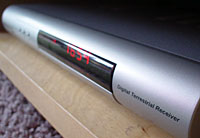 Onscreen menus
Onscreen menus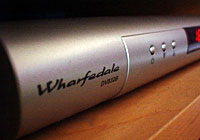 Picture quality
Picture quality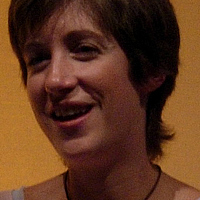 Industry experts at the inaugural mobile TV show in London today couldn’t agree on the best way forward for this emerging technology.
Industry experts at the inaugural mobile TV show in London today couldn’t agree on the best way forward for this emerging technology.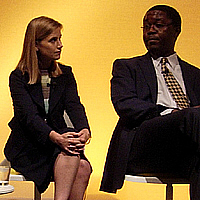 Hyacinth Nwana, (pictured left) speaking for Arqiva, and Jeremy Wright of Enpocket, both saw advertiser funded content – whether programming or entertaining video ‘spots’ – to be the key driver.
Hyacinth Nwana, (pictured left) speaking for Arqiva, and Jeremy Wright of Enpocket, both saw advertiser funded content – whether programming or entertaining video ‘spots’ – to be the key driver.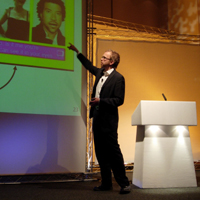 Eirik Solheim of Finnish state broadcaster NRK, (pictured right) said their mobile TV trials had seen some success with pay-per-view.
Eirik Solheim of Finnish state broadcaster NRK, (pictured right) said their mobile TV trials had seen some success with pay-per-view.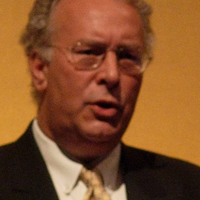 The UK production and development community is in danger of losing out to competition from overseas if it doesn’t wake up to the potential of mobile TV, said Mark Selby, Nokia’s Global Vice President for Multimedia, (pictured right) at the inaugural Mobile TV forum in London today.
The UK production and development community is in danger of losing out to competition from overseas if it doesn’t wake up to the potential of mobile TV, said Mark Selby, Nokia’s Global Vice President for Multimedia, (pictured right) at the inaugural Mobile TV forum in London today.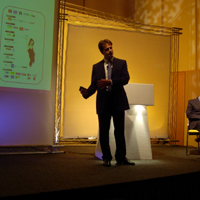 But many claimed that the lack of spectrum is holding DVB-H back in the UK.
But many claimed that the lack of spectrum is holding DVB-H back in the UK.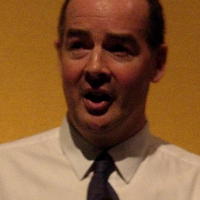 Digital One owns the UK’s only nationwide commercial DAB multiplex – but the capacity allocated for DMB is minimal.
Digital One owns the UK’s only nationwide commercial DAB multiplex – but the capacity allocated for DMB is minimal.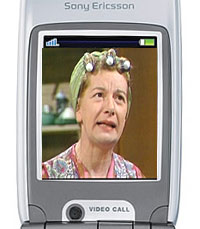 A report by Unstrung Insider claims that Mobile TV is set to become a breakthrough mass-market mobile data service, boosted by pioneering services offered by major global operators such as Orange, Vodafone, and SK Telecom.
A report by Unstrung Insider claims that Mobile TV is set to become a breakthrough mass-market mobile data service, boosted by pioneering services offered by major global operators such as Orange, Vodafone, and SK Telecom.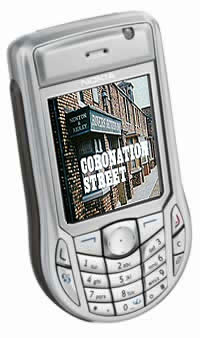 The report comments on the industry expectation that “one-to-many” mass-market mobile TV services may be more efficiently delivered over dedicated mobile broadcast networks using technologies such as DVB-H (Digital Video Broadcast-Handheld), DMB (Digital Multimedia Broadcast), and MediaFLO.
The report comments on the industry expectation that “one-to-many” mass-market mobile TV services may be more efficiently delivered over dedicated mobile broadcast networks using technologies such as DVB-H (Digital Video Broadcast-Handheld), DMB (Digital Multimedia Broadcast), and MediaFLO.